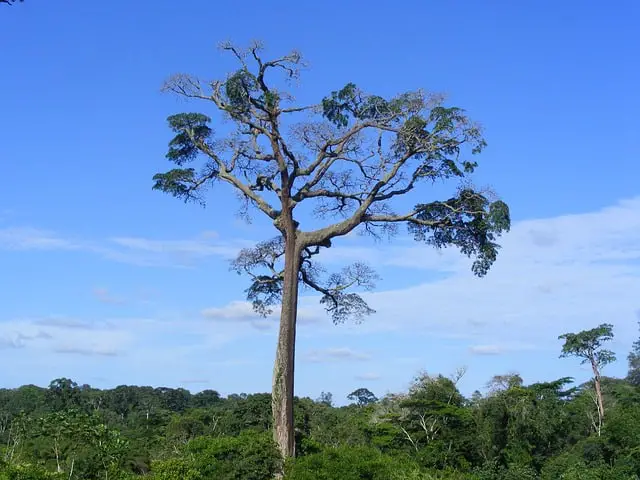Moabi wood, derived from the Moabi tree (Baillonella toxisperma), is a valuable and versatile tropical hardwood primarily found in Central and West Africa.
Moabi is highly regarded for its durability, strength, and attractive appearance, making it suitable for various commercial and woodworking applications including furniture, flooring, cabinetry and boat building among others.
Below, we’ll go into more detail about Moabi wood to learn not only about its uses but also its commercial appeal and important characteristics.
Moabi Wood Has Numerous Commercial Uses
Here are some common uses and characteristics of Moabi wood:
- Furniture: Moabi wood is often used to craft high-quality furniture due to its beautiful grain pattern and rich reddish-brown to dark brown color. It’s especially popular for creating cabinets, tables, chairs, and fine wooden pieces.
- Flooring: Its durability and resistance to wear make Moabi wood an excellent choice for hardwood flooring. It can withstand heavy foot traffic and remain visually appealing for many years.
- Cabinetry: Moabi wood’s stability and attractive appearance make it a preferred choice for crafting kitchen cabinets, wardrobes, and storage solutions.
- Veneer: Moabi wood can be sliced into thin veneer sheets and used to cover the surfaces of furniture, doors, and other decorative elements to achieve a high-end finish.
- Boat Building: Due to its natural resistance to water and rot, Moabi wood is sometimes used in boat construction and marine applications.
- Musical Instruments: It is occasionally used in crafting musical instruments like guitars, especially for the back and sides, thanks to its tonal properties and beautiful grain.
- Interior Trim: Moabi wood can be used for interior trim work, including baseboards, moldings, and decorative accents.
- Turned Objects: Its workability and attractive appearance make Moabi wood suitable for turning into decorative items like bowls, vases, and sculptures.
Moabi Wood and Tree Characteristics Summarized
Here’s a table summarizing the characteristics of Moabi trees and wood to illustrate what if offers and why it has such commercial appeal:
| Characteristic | Description |
|---|---|
| Scientific Name | Baillonella toxisperma |
| Common Names | Moabi, African Pearwood, Mukulungu |
| Family | Sapotaceae |
| Origin | Central and West Africa |
| Tree Height | Up to 50 meters (164 feet) |
| Wood Color | Light to medium reddish-brown |
| Wood Grain | Interlocked and often wavy |
| Density | High density wood |
| Durability | Highly durable and resistant to decay |
| Workability | Can be difficult to work due to density |
| Uses | – Fine furniture |
| – Flooring and cabinetry | |
| – Boat building | |
| – Veneer and decorative woodworking | |
| Resistance | Resistant to termites and fungal decay |
| Finishing | Takes finishes well; finishes to a lustrous sheen |
| Sustainability | Concerns over logging and conservation efforts |
| Availability | Limited availability due to overharvesting |
Please note that Moabi wood is highly valued for its durability and appearance, but there are sustainability concerns due to overharvesting. It’s important to source Moabi wood from responsible and sustainable forestry practices to support conservation efforts and protect these valuable trees.

Moabi Wood Substitutes
Can’t source Moabi wood for your projects? Below we’ll discuss some viable alternatives that might be easier to find.
While Moabi wood is a unique and desirable material, these are some alternatives you can consider if you’re looking for similar characteristics:
- Mahogany: Mahogany is known for its reddish-brown color, fine grain, and durability. It’s commonly used in fine furniture and cabinetry.
- Sapele: Sapele wood has a similar appearance to Mahogany, with a reddish-brown color and interlocked grain. It’s often used as a Mahogany substitute in woodworking.
- African Padauk: Padauk is valued for its vibrant orange to reddish-brown color and is used in fine woodworking, including furniture and decorative items.
- Iroko: Iroko is an African hardwood with a golden to medium brown color and interlocked grain. It’s used in boat building, flooring, and outdoor applications.
- Teak: Teak wood is known for its golden-brown color, durability, and resistance to decay. It’s commonly used in outdoor furniture and boat decking.
- Cherry: Cherry wood has a warm reddish-brown color and fine grain. It’s often used in fine furniture and cabinetry.
- Walnut: Walnut wood is prized for its dark brown color, rich grain, and workability. It’s used in high-quality furniture and gunstocks.
- Maple: Maple wood has a light, creamy color and a fine, uniform grain. It’s popular in cabinetry, flooring, and woodworking.
When choosing a substitute for Moabi wood, consider the specific characteristics you’re looking for in your project, such as color, grain, and durability, and choose a wood that best matches your needs. Additionally, ensure that the wood you select is sourced responsibly and sustainably.
Final Thoughts
Moabi wood’s combination of strength, durability, and aesthetic appeal makes it a valuable resource for various woodworking and construction projects. However, it’s essential to consider sustainable sourcing practices to ensure the long-term availability of this precious tropical hardwood.
In summary:
- Color: Moabi wood typically ranges from reddish-brown to dark brown with occasional darker streaks. It may darken with age and exposure to light.
- Grain: The wood has a straight to interlocked grain, which can result in attractive patterns.
- Density: Moabi wood is known for its high density, contributing to its durability and resistance to wear and tear.
- Workability: While it can be challenging to work with due to its hardness, Moabi wood can be machined and finished to a smooth surface.
- Durability: Moabi wood exhibits natural resistance to decay and insects, making it suitable for outdoor applications.
- Finish: The wood accepts finishes well, allowing for a polished, glossy appearance when desired.


